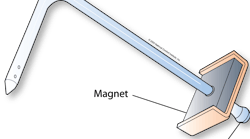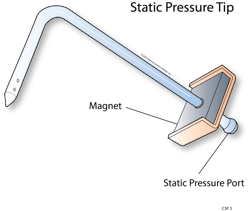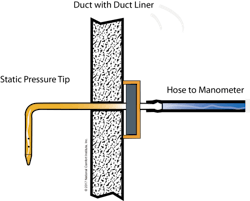A static pressure tip is a small pressure-testing accessory that makes a big difference in the accuracy and repeatability of HVAC air pressure measurements.
Let's take a look at what it is, how it helps your testing, and why you should use one each time you measure static pressure.
You compare measured static pressure to a specified pressure to discover and diagnose system issues, such as resistance to airflow and what volume of air the fan is moving.
Description
A static pressure tip is a small metal tube about four inches long. It costs around $10 to $15 and is available across the industry.
The model you want has a 90-degree bend near the insertion tip with a pointed end and several very small holes for static pressure to enter. It also has a magnet to hold the tip in place when you test pressures within metal ducts or equipment.
Pressure tubing attaches to the static pressure port and transfers static pressure from the air stream to a manometer pressure gauge. The unit of pressure most of us use in the HVAC Industry to measure static pressure is inches of water column (W.C.)
The Tip Isolates Static Pressure
Install a test port to get access into the air stream. Insert the pointed end of the static pressure tip directly into the airstream. The pointed tip breaks up anotherpressure in the duct system called velocity pressure and diverts it away from the small holes near the tip. This action allows only static pressure to enter the tip and display on the manometer.
Several errors may occur if you test without a static pressure tip and use the end of a pressure tube or a straight probe. The first error is that the pressure reading on the manometer may be high. This is because you may be picking up velocity pressure that gives a false reading.
Also, without the pointed tip to break up turbulence, you'll see the pressure reading jump around on your manometer, making it impossible to read.
RELATED:
Static Pressure Testing: How, Where, Why
Measuring Static Pressure in Six Simple Steps
Six Secrets for Accurate Static Pressure Testing
Static Pressure Behavior
Static pressure operates according to definite and consistent laws of nature. The better you understand pressure laws, the easier it becomes to see how they work. As you test, your confidence will increase, as will your diagnostic ability.
The best way to "see" static pressure in a duct system is to test it and then try to mess up your readings and figure out why. Purposely messing up your pressure readings sounds counterproductive, but you will see and learn with each different scenario and from changes in pressure readings.
To experience static pressure behavior firsthand, here are several experiments you may try in the field.
1. Install a test port on one side of a duct to measure and record static pressure. Then, install a test port on the opposite side of the duct to do the same. Compare the two readings. How different were the two pressures? Or were they the same? Why?
2. Measure and record pressure in the duct five feet after the air handling equipment, then test pressure five feet before a supply register. Were they the same? Was one higher? If different, why?
3. Measure static pressures before and after the air handling equipment. Did you notice one pressure had a negative symbol before the pressure? What does the negative symbol mean?
4. Take and record static pressure readings before and after a filter. Subtract the two pressures. What does this pressure reading mean?
Notice I didn't give you any answers for these experiments. However, I promise if you take the time to try these exercises and think about what you see, you may soon know more than most veteran service techs. I'd love to hear what you learn as you open the door wider to static pressure measurement.
National Comfort Institute's David Richardson Participates in a Static Pressure Discussion by HVAC Shop Talk:
A Few More Tips
Field measurement is and always will be subject to changing conditions. It's never perfect. Many laws of nature are at play all at once, and pressures constantly change because of variable-speed fans, coils getting wet, and duct defects. Such variables may sometimes scramble your brain and keep you up at night. But you can learn from each experience.
One challenge is that about one in 15 pressure readings is inaccurate. This obstacle requires experience to recognize when another reading is needed. Substandard readings may be caused by air turbulence in ducts, equipment obstacles, loose duct liner, damaged duct, and air leakage.
Install an additional test port a few inches away and compare the two pressure measurements.
Be careful not to pinch or step on your pressure tubing. Depending on the tubing material, it may take very little pressure to add to or subtract from the measured pressure and give a false reading.
Static pressure tips may also become dirty or blocked in your tool bag. Blow them out and ensure they remain clean.
The magnets that fix the tip to the duct or equipment may fall off. One solution is to apply high-strength glue to fix the magnet in place permanently.
Finally, select a manometer that matches the type of static pressure testing you'll do. An analog manometer should have two test ports for most testing and include a 0-1-in.W.C range and read to within 1/100th of an inch. Digital gauge ranges may be from 0-5-in. W.C.
Static pressure tips are cheap, widely available, and enhance your pressure testing and diagnostics. Is it time to upgrade your static pressure testing and diagnostics?
Rob "Doc" Falke serves the industry as president of National Comfort Institute, Inc., an HVAC-based training company and membership organization. If you're an HVAC professional interested in a free procedure to measure filter pressure drop, contact Doc at ncilink.com/ContactMe or call 800-633-7058. Go to NCI's website at nationalcomfortinstitute.com for free information, articles, downloads, and current training opportunities











